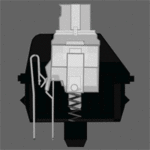Mechanical Keyboards
| Language: | English |
|---|
| Mechanical Keyboards | |

| |
| Status: | active |
| Thema: | Collecting and experimenting with mechanical switches and keycaps to find or create the ultimate keyboard. |
| Gestartet: | 04.05.2017 |
| Organisator: | Filnamos, [User:anlumo |
| Treffen: | on demand |
| Zielgruppe: | People who type regularily. |
| Inhalt: | |
| Zuletzt aktualisiert: | 2017-05-04 |
Mechanical Keyboards
Keyboards have a long tradition for text entry that dates back to the first typewriters. Even today, most computers ship with one!
Different technologies for implementing their buttons have emerged, from capacitive surfaces with no haptic feedback (except the hard surface) whatsoever to mechanical keyswitches, who go to great lengths to provide a clear feedback to the user. Between these extremes, there are membrane and dome switches, that are preferred for low-profile keyboards, such as used in most notebooks. A notable exception was developed by MSI.
However, no clear winner in keyswitch technologies has yet been developed, different people prefer different technologies for productive typing and gaming.
The Mechanical Keyboard Community
Around mechanical keyswitches, a community of enthusiasts has developed, who collect them and keyboards featuring them. Technologies around them, like keycaps and backlighting are also explored. These people like to try out different haptics, some in order to come up with their ultimate keyboard (although the personal definition of the ultimate keyboard might also be situational, for example you don't want to use a loud clicky keyboard in a library). For others, this has also become a numismatics-like obsession, so they collect various different types to get a complete collection of all the types that are available.
The Technology Behind It
A typical modern keyboard consists of the following components:
- a case
- a PCB (with diodes to avoid ghosting)
- a USB controller
- keyswitches
- keycaps
Case
Mechanical keyboards come in all types and sizes. Usually, they are denoted in percent-values of a full keyboard (with 105 keys). For example, a 60% keyboard has about 60 keys.
Usual keyboard sizes are:
- 100%
- 80%: no numpad
- 60%: no F-keys
- 40%: no number keys, no arrow keys
Missing keys are replaced by additional shift keys to have multiple functions on a single key. In the community, the 60% keyboards seem to be the most popular ones.
Case materials are very free-form and usually dictate the way they're produced. Typical materials are (ordered by one-off costs):
- Injection-molded ABS
- Milled aluminium or other metals
- Laser-cut acrylic
- Wood: milled, laser-cut or hand-carved
Note that all of these machining methods with the exception of injection molding are readily available at metalab.
Cases usually also include a plate to hold the keyswitches in place. This is usually a laser-cut aluminium plate. These we can't produce at metalab, but they can be ordered, or you can buy a standard one if you don't want a special layout.
PCB
PCBs are actually optional for mechanical keyswitches, since they can be soldered free-form. However, if you want to make one properly or you just buy one, they come with a PCBs for improved stability and easy integration with the USB controller (which always needs some kind of PCB).
Details on how to create your own PCB can be found here for KiCAD. Note that these PCBs are pretty expensive to produce, due to their physical size. If you want to use a standard layout, there are also complete PCBs available to buy online.
USB Controller
Off-the-shelf PCBs have the USB controller onboard, so nothing further is required for these. Many self-made ones use a Teensy or something similar as a USB controller, because there's open source software available for them. Note that the Teensy is available at the hacker.parts machine at metalab.
Keyswitches
This is the hardest part of a keyboard. Fortunately, off-the-shelf parts are available at affordable prices (EUR 60-120 for a full keyboard). Every type of keyswitch has its unique response pattern to physical manipulation. The exact resistance at every point in the push is documented in the manufacturer's datasheet.
Many enthusiast keyboards also don't come with mounted keyswitches, so the buyer can solder their own favorite switch. Most keyswitches use the same PCB pattern, so they're interchangeable. This happened because many manufacturers copied Cherry's design.
The keyswitch type can usually identified by the color of the stem (this has only marketing reason, not technical). Cherry has defined some colors some others like Gateron copy. Sometimes the colors of different manufacturers also have different meanings. Common types are explained in this article.